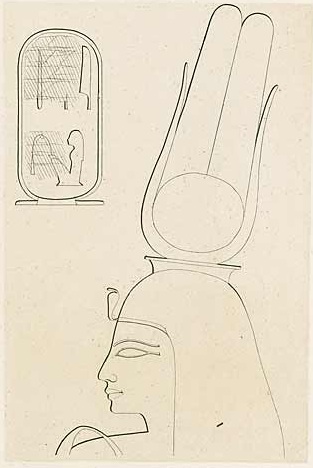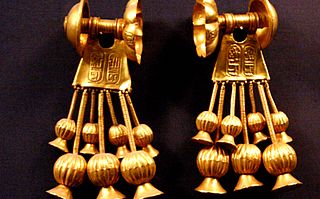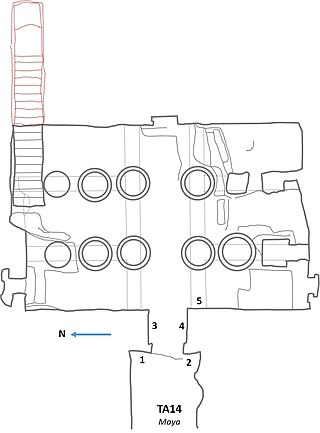
Amarna is an extensive Egyptian archaeological site containing the remains of what was the capital city of the late Eighteenth Dynasty. The city was established in 1346 BC, built at the direction of the Pharaoh Akhenaten, and abandoned shortly after his death in 1332 BC. The name that the ancient Egyptians used for the city is transliterated as Akhetaten or Akhetaton, meaning "the horizon of the Aten".

Akhenaten, also spelled Akhenaton or Echnaton, was an ancient Egyptian pharaoh reigning c. 1353–1336 or 1351–1334 BC, the tenth ruler of the Eighteenth Dynasty. Before the fifth year of his reign, he was known as Amenhotep IV.

Nefertiti was a queen of the 18th Dynasty of Ancient Egypt, the great royal wife of Pharaoh Akhenaten. Nefertiti and her husband were known for their radical overhaul of state religious policy, in which they promoted the earliest known form of monotheism, Atenism, centered on the sun disc and its direct connection to the royal household. With her husband, she reigned at what was arguably the wealthiest period of ancient Egyptian history. Some scholars believe that Nefertiti ruled briefly as the female king Neferneferuaten after her husband's death and before the ascension of Tutankhamun, although this identification is a matter of ongoing debate. If Nefertiti did rule as Pharaoh, her reign was marked by the fall of Amarna and relocation of the capital back to the traditional city of Thebes.

Smenkhkare was an ancient Egyptian pharaoh of unknown background who lived and ruled during the Amarna Period of the 18th Dynasty. Smenkhkare was husband to Meritaten, the daughter of his likely co-regent, Akhenaten. Since the Amarna period was subject to a large-scale condemnation of memory by later Pharaohs, very little can be said of Smenkhkare with certainty, and he has hence been subject to immense speculation.
Thutmose, also known as "The King's Favourite and Master of Works, the Sculptor Thutmose", was an Ancient Egyptian sculptor in the Amarna style. He flourished around 1350 BC, and is thought to have been the official court sculptor of the Egyptian pharaoh Akhenaten in the latter part of his reign. A German archaeological expedition digging in Akhenaten's deserted city of Akhetaten, known today as Amarna, found a ruined house and studio complex in early December 1912; the building was identified as that of Thutmose based on an ivory horse blinker found in a rubbish pit in the courtyard inscribed with his name and job title. Since it gave his occupation as "sculptor" and the building was clearly a sculpture workshop, the determination seemed logical and has proven to be accurate.

Meritaten, also spelled Merytaten, Meritaton or Meryetaten, was an ancient Egyptian royal woman of the Eighteenth Dynasty of Egypt. Her name means "She who is beloved of Aten"; Aten being the sun-deity whom her father, Pharaoh Akhenaten, worshipped. She held several titles, performing official roles for her father and becoming the Great Royal Wife to Pharaoh Smenkhkare, who may have been a brother or son of Akhenaten. Meritaten also may have served as pharaoh in her own right under the name Ankhkheperure Neferneferuaten.

Tey was the Great Royal Wife of Kheperkheprure Ay, who was the penultimate pharaoh of Ancient Egypt's Eighteenth Dynasty. She also had been the wet nurse of Nefertiti.

Tomb KV56, also known as the Gold Tomb, is a tomb located in the Valley of the Kings, near Luxor, Egypt. It was discovered by Edward R. Ayrton in January 1908 and contained what is thought to be the intact burial of a royal child from the late Nineteenth Dynasty. The burial and casket have disintegrated, leaving a thin layer of gold leaf and stucco in the original location. Most famously the tomb contained spectacular gold and silver jewellery including earrings, rings, silver bracelets with the names of Seti II and Twosret inscribed, and a pair of small silver gloves. The original occupant of this tomb is unknown but was possibly an Eighteenth Dynasty queen.

Panehesy was an Egyptian noble who bore the titles of 'Chief servitor of the Aten in the temple of Aten in Akhetaten'.

The Valley of the Kings, also known as the Valley of the Gates of the Kings, is an area in Egypt where, for a period of nearly 500 years from the Eighteenth Dynasty to the Twentieth Dynasty, rock-cut tombs were excavated for pharaohs and powerful nobles under the New Kingdom of ancient Egypt.

Meryre II was an ancient Egyptian noble known as the superintendent of Queen Nefertiti, and held the title of royal scribe, steward, overseer of the two treasuries, overseer of the royal harem of Nefertiti. He had a tomb constructed at Amarna, although his remains have never been identified. The tomb has the last dated appearance of Akhenaten and the Amarna family.
Carl Nicholas Reeves, FSA, is a British Egyptologist, archaeologist and museum curator.

Neferneferuaten Tasherit or Neferneferuaten the younger was an ancient Egyptian princess of the 18th Dynasty and the fourth daughter of Pharaoh Akhenaten and his Great Royal Wife Nefertiti.
Geoffrey Almeric Thorndike Martin was a British egyptologist, Edwards Professor of Egyptian Archaeology and Philology Emeritus, University College, London, Joint Field Director of the Amarna Royal Tombs Project and fellow commoner of Christ's College, Cambridge.
Ankhkheperure-Merit-Neferkheperure/Waenre/Aten Neferneferuaten was a name used to refer to a female king who reigned toward the end of the Amarna Period during the Eighteenth Dynasty. Her gender is confirmed by feminine traces occasionally found in the name and by the epithet Akhet-en-hyes, incorporated into one version of her nomen cartouche. She is distinguished from the king Smenkhkare who used the same throne name, Ankhkheperure, by the presence of epithets in both cartouches. She is suggested to have been either Meritaten or, more likely, Nefertiti. If this person is Nefertiti ruling as sole king, it has been theorized by Egyptologist and archaeologist Zahi Hawass that her reign was marked by the fall of Amarna and relocation of the capital back to the traditional city of Thebes.
The North City was an administrative area in the ancient Egyptian city of Amarna in Upper Egypt, the short-lived capital of Pharaoh Akhenaten of the 18th Dynasty. It contains the ruins of royal palaces, especially the Northern Palace and other administrative buildings and occupies an area between the river and the cliffs that terminate the plains to the north of the city itself.

A necropolis is a large, designed cemetery with elaborate tomb monuments. The name stems from the Ancient Greek νεκρόπολις nekropolis.
The succession of kings at the end of the Eighteenth Dynasty of Ancient Egypt is a matter of great debate and confusion. There are very few contemporary records that can be relied upon, due to the nature of the Amarna Period and the reign of Akhenaten and his successors and possible co-regents. It is known that Akhenaten reigned for seventeen years, and it was previously believed that in the last 3 or 4 years, he had two co-regents: Smenkhkare, who was possibly his brother or son, and Neferneferuaten, who was either one of his daughters or his Great Royal Wife Nefertiti. It is unknown in which order they followed each other, and neither of their reigns lasted long, for Tutankhamun succeeded not long after Akhenaten's death.

Amarna Tomb 3 is a rock-cut cliff tomb located in Amarna, Upper Egypt. The tomb belonged to the Ancient Egyptian noble Ahmes (Ahmose), who served during the reign of Akhenaten. The tomb is situated at the base of a steep cliff and mountain track at the north-eastern end of the Amarna plains. It is located in the northern side of the wadi that splits the cluster of graves known collectively as the Northern tombs. Amarna Tomb 3 is one of six elite tombs belonging to the officials of Akhenaten. It was one of the first Northern tombs, built in Year 9 of the reign of Akhenaten.

May was an ancient Egyptian official during the reign of Pharaoh Akhenaten. He was Royal chancellor and fan-bearer at Akhet-Aten, the pharaoh's new capital. He was buried in Tomb EA14 in the southern group of the Amarna rock tombs. Norman de Garis Davies originally published details of the Tomb in 1908 in the Rock Tombs of El Amarna, Part V – Smaller Tombs and Boundary Stelae. The tomb dates to the late 18th Dynasty.













